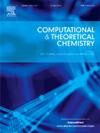SiC/WS2层状异质结复合陶瓷的理论研究:促进陶瓷工艺设计
IF 3
3区 化学
Q3 CHEMISTRY, PHYSICAL
引用次数: 0
摘要
新型陶瓷复合材料的发展有利于提高陶瓷器件的设计质量和性能。本研究利用第一性原理计算方法开发了SiC/WS2异质结复合材料,特别是SiC/WS2、SiC/WS2/SiC和WS2/SiC/WS2,并通过双轴应变和垂直应变的应用研究了其性能的调制。研究结果表明,这三种类型的SiC/WS2异质结都具有良好的结构稳定性。此外,每个异质结具有直接带隙半导体特性,带隙能量在1.392 eV到1.479 eV之间。应变的应用系统地影响了SiC/WS2异质结的电子性能,三层异质结对应变效应表现出更高的敏感性。这种三层结构也表现出增强的层间电荷转移和光吸收能力。SiC/WS2异质结优越的电子性能突出了其在电子和光电子陶瓷器件中的潜在应用。本文章由计算机程序翻译,如有差异,请以英文原文为准。

Theoretical study of SiC/WS2 layered heterojunction composite ceramics: Promoting ceramic process design
The advancement of novel ceramic composite materials is advantageous for improving the design quality and performance of ceramic devices. This study utilizes first-principles computational methods to develop SiC/WS2 heterojunction composite materials, specifically SiC/WS2, SiC/WS2/SiC, and WS2/SiC/WS2, and examines the modulation of their properties through the application of biaxial and vertical strain. The findings reveal that all three types of SiC/WS2 heterojunctions exhibit commendable structural stability. Furthermore, each heterojunction displays direct bandgap semiconductor characteristics, with bandgap energies ranging from 1.392 eV to 1.479 eV. The application of strain systematically influences the electronic properties of the SiC/WS2 heterojunctions, with the three-layer heterojunction demonstrating heightened sensitivity to strain effects. This three-layer configuration also exhibits enhanced interlayer charge transfer and light absorption capabilities. The superior electronic properties of the SiC/WS2 heterojunctions underscore their potential utility in electronic and optoelectronic ceramic devices.
求助全文
通过发布文献求助,成功后即可免费获取论文全文。
去求助
来源期刊

Computational and Theoretical Chemistry
CHEMISTRY, PHYSICAL-
CiteScore
4.20
自引率
10.70%
发文量
331
审稿时长
31 days
期刊介绍:
Computational and Theoretical Chemistry publishes high quality, original reports of significance in computational and theoretical chemistry including those that deal with problems of structure, properties, energetics, weak interactions, reaction mechanisms, catalysis, and reaction rates involving atoms, molecules, clusters, surfaces, and bulk matter.
 求助内容:
求助内容: 应助结果提醒方式:
应助结果提醒方式:


